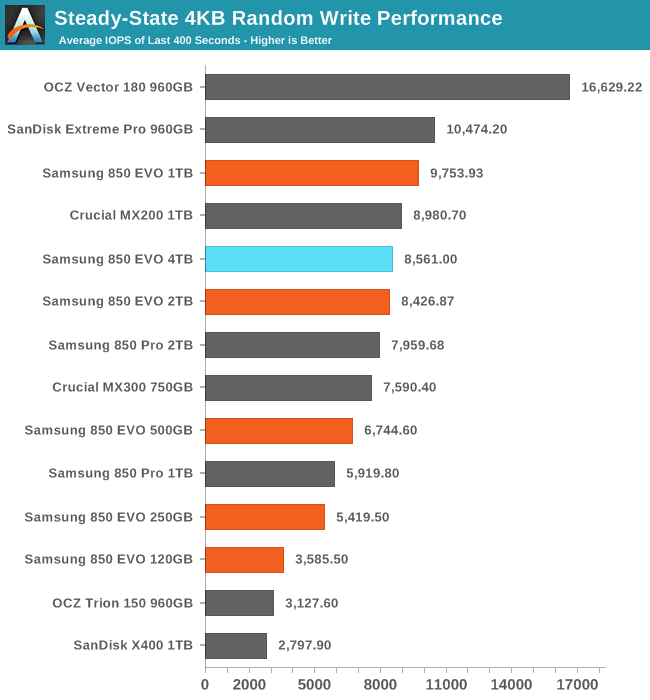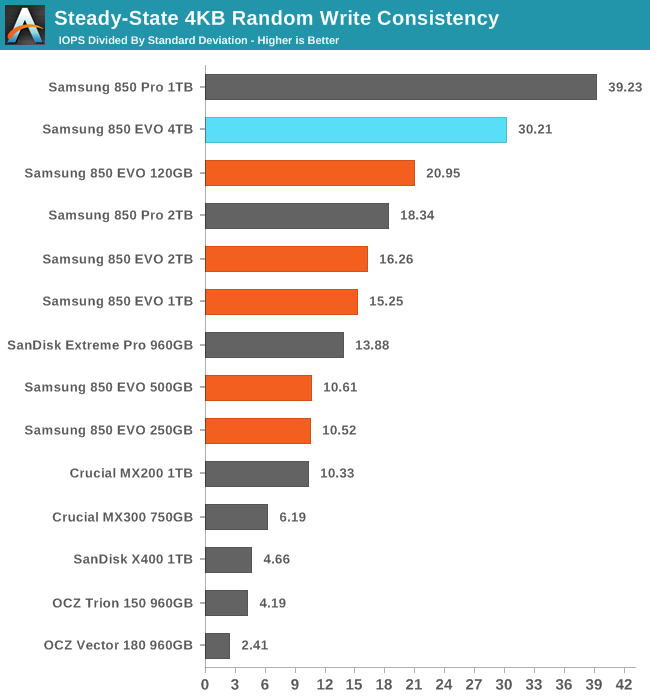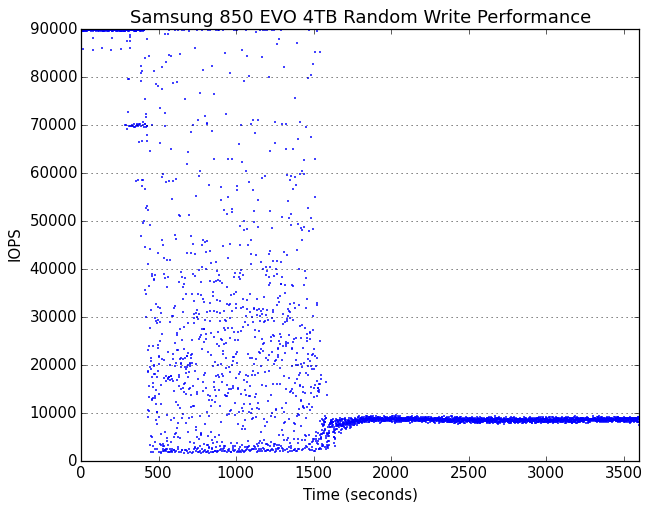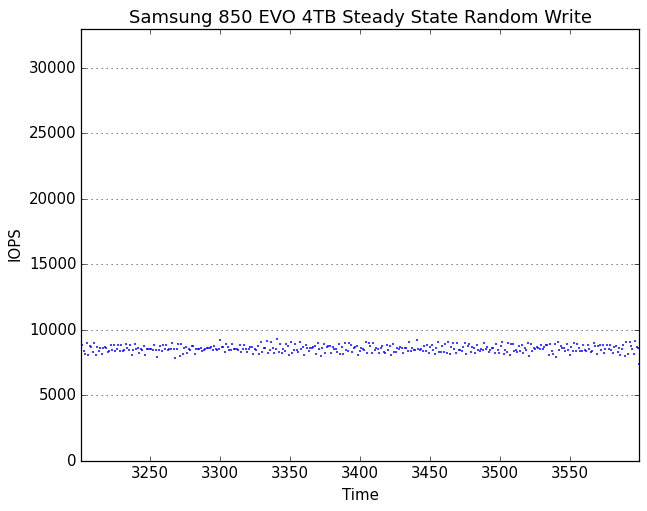The Samsung 850 EVO 4TB SSD Review
by Billy Tallis on July 11, 2016 10:00 AM ESTPerformance Consistency
Our performance consistency test explores the extent to which a drive can reliably sustain performance during a long-duration random write test. Specifications for consumer drives typically list peak performance numbers only attainable in ideal conditions. The performance in a worst-case scenario can be drastically different as over the course of a long test drives can run out of spare area, have to start performing garbage collection, and sometimes even reach power or thermal limits.
In addition to an overall decline in performance, a long test can show patterns in how performance varies on shorter timescales. Some drives will exhibit very little variance in performance from second to second, while others will show massive drops in performance during each garbage collection cycle but otherwise maintain good performance, and others show constantly wide variance. If a drive periodically slows to hard drive levels of performance, it may feel slow to use even if its overall average performance is very high.
To maximally stress the drive's controller and force it to perform garbage collection and wear leveling, this test conducts 4kB random writes with a queue depth of 32. The drive is filled before the start of the test, and the test duration is one hour. Any spare area will be exhausted early in the test and by the end of the hour even the largest drives with the most overprovisioning will have reached a steady state. We use the last 400 seconds of the test to score the drive both on steady-state average writes per second and on its performance divided by the standard deviation.

The 4TB 850 EVO restores a little bit of the performance that the 2TB lost relative to the 1TB, but Samsung's controller architecture is still clearly most comfortable at 1TB.

The consistency of the 2TB 850 EVO was only slightly better than the 1TB EVO, so it's surprising to see the 4TB model make such a large jump and come so close to the 1TB 850 Pro.
 |
|||||||||
| Default | |||||||||
| 25% Over-Provisioning | |||||||||
It is no surprise that a 4TB drive lasts so long before dropping out of peak performance: it has far more spare area to burn through than any ordinary consumer SATA SSD. The transition to steady state is uncharacteristically long and messy for a Samsung drive, and the performance lows during this period are disappointing. Once the drive has reached steady state, there's nothing to complain about.
 |
|||||||||
| Default | |||||||||
| 25% Over-Provisioning | |||||||||
There are no wild outliers from the 4TB 850 EVO's steady-state, and none of the longer-term drift in performance shown by the 1TB and 2TB 850 EVO and Pro models. With extra overprovisioning, the 4TB EVO carries on indefinitely with high and extremely steady performance.










145 Comments
View All Comments
ddriver - Monday, July 11, 2016 - link
That's a valid point, and even though majority of the people who buy consumer stuff are gonna use it on windows, it is still no excuse, it is not like samsung doesn't have the resources to dedicate to proper support.Palorim12 - Tuesday, July 12, 2016 - link
Linux is the only OS affected. Windows and Mac are fine. Disable Queued TRIM and Sequential TRIM will run. So NBD.Kevin G - Monday, July 11, 2016 - link
Samsung has horrible warranty support and they have had a few major issues with their SDDs (840 EVO performance degradation).Samus - Monday, July 11, 2016 - link
Yeah. I had two really sour back to back experiences with Samsung Storage support, one regarding the 840 EVO. After a month of back and fourth communication attempting different firmware updates as support requested, secure erase and reimage, and even trying the drive in another PC as support asked, it was obvious they were in denial of the well documented read performance problem. After RMA they shipped me back another 840 EVO that eventually (after a year) developed the same problems even with the latest firmware update. The problems always come up after a lot of writes like a game install. It wasn't worth the trouble. I would have been happy if they simply replaced the drive with an 850 EVO.Palorim12 - Tuesday, July 12, 2016 - link
The FW update that came out in April completely fixed the issue. I posted several updates on a 840 EVO and an 840 EVO m-sata on Overclock that are fine well over a year since the fix.Palorim12 - Tuesday, July 12, 2016 - link
And they also came out with a fix for the non-EVO 840 recently.Impulses - Wednesday, July 13, 2016 - link
Did they? That's news to me! To teh Google...Impulses - Wednesday, July 13, 2016 - link
Huh, go figure, they DID issue an 840 update towards the end of June (2016)... What the heck took so long? I think most people had rightfully assumed the 840 (non EVO) was abandoned, the EVO did come out like 6 months after it.Apparently the issue was also never quite as severe on the 840 non EVO? Did they ever commit to a fix and it got drowned out over time or did that update happen out of the blue? No AT Pipeline post about it either...
http://www.pcper.com/reviews/Storage/Samsung-Magic...
Palorim12 - Thursday, July 14, 2016 - link
I think its because in most cases, it took longer for the issue to appear in the 840. So it would take longer for them to see if a fix fully worked?SetiroN - Monday, July 11, 2016 - link
Why wouldn't you?When you're talking TBs, that difference translates in HUNDREDS of dollars that I have better use for when Sandisk's performance is already good enough.
This drive only really makes sense in oddly demanding small laptops.